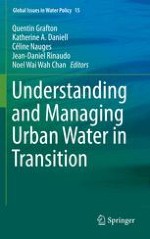2015 | OriginalPaper | Buchkapitel
17. A Simulation Model for Understanding the Consequences of Alternative Water and Wastewater Tariff Structures: A Case Study of Fayoum, Egypt
verfasst von : Céline Nauges, Dale Whittington, Mohamed El-Alfy
Erschienen in: Understanding and Managing Urban Water in Transition
Verlag: Springer Netherlands
Aktivieren Sie unsere intelligente Suche, um passende Fachinhalte oder Patente zu finden.
Wählen Sie Textabschnitte aus um mit Künstlicher Intelligenz passenden Patente zu finden. powered by
Markieren Sie Textabschnitte, um KI-gestützt weitere passende Inhalte zu finden. powered by
